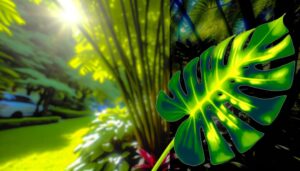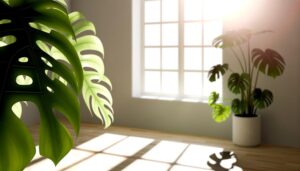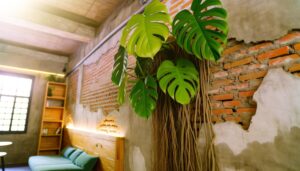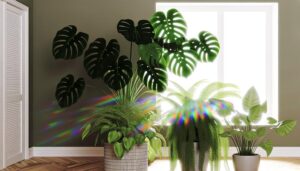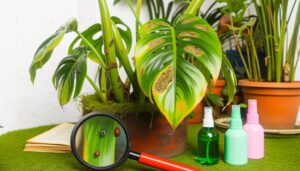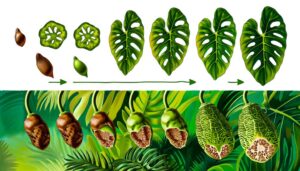Can Monstera Deliciosa Live in Low Light? Find Out Here!
Monstera deliciosa can adeptly survive in low light conditions by employing a series of morphological and physiological adaptations. These include elongation of stems (etiolation) and increased leaf surface area to maximize photon capture.
However, less-than-ideal light intensity can lead to reduced fenestration, chlorosis, and compromised photosynthesis. For peak growth, indirect light and additional full-spectrum LED grow lights are recommended.
Placement near indirect light sources while avoiding direct sunlight also supports necessary physiological processes. Continuous monitoring and adjustments ensure the plant thrives under low light conditions.
Further exploration will reveal detailed strategies and care techniques to maintain its health.
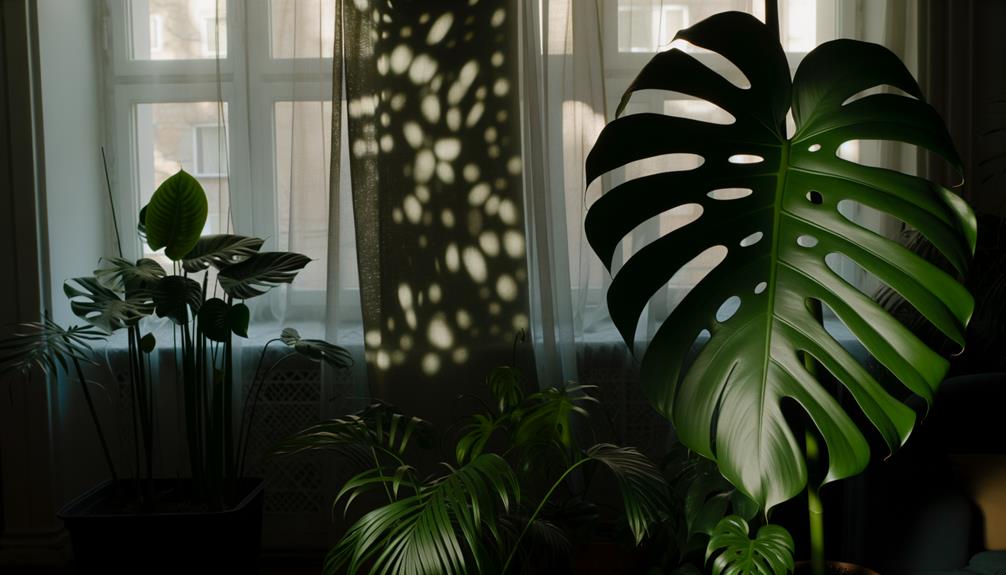
Key Takeaways
- Monstera Deliciosa can survive in low light but prefers indirect light for optimal growth.
- In low light, Monstera may develop larger leaves to capture more photons.
- Signs of light deprivation include elongated stems and yellowing leaves.
- Supplemental lighting, such as full-spectrum LED grow lights, can help maintain health in low light conditions.
- Avoid direct sunlight, as it can damage Monstera leaves.
Understanding Monstera Light Needs

Understanding the light needs of Monstera deliciosa involves analyzing its natural habitat, which is characterized by the diffuse sunlight conditions of tropical forest understories. These environments provide indirect light, filtered through dense canopy layers, mimicking a low to medium light intensity.
Monstera deliciosa, a hemiepiphytic plant, adapts to varying light levels by utilizing its large fenestrated leaves to maximize photosynthesis under subpar light conditions. Chlorophyll concentration and leaf morphology are evolutionary adaptations that enhance light capture and utilization.
For indoor cultivation, replicating these conditions involves placing the plant in areas with bright indirect light, avoiding direct sunlight exposure which can lead to photoinhibition and foliar damage. Consequently, understanding these needs is crucial to ensuring optimal growth and health of Monstera deliciosa.
Signs of Light Deprivation
When Monstera deliciosa does not receive adequate light, it exhibits several physiological and morphological signs indicative of light deprivation.
These manifestations may include:
- Etiolation: Elongation of stems and petioles as the plant stretches towards available light, resulting in a leggy appearance.
- Chlorosis: Yellowing of the leaves due to insufficient chlorophyll synthesis, impeding photosynthesis.
- Reduced Fenestration: Decrease in the characteristic leaf perforations and splits, which are less pronounced under low light conditions.
These indicators highlight the plant’s struggle to photosynthesize efficiently and maintain its structural integrity. Recognizing these signs promptly is important for implementing corrective measures to maintain Monstera deliciosa’s health and strength in suboptimal lighting environments.
Low Light Survival Strategies
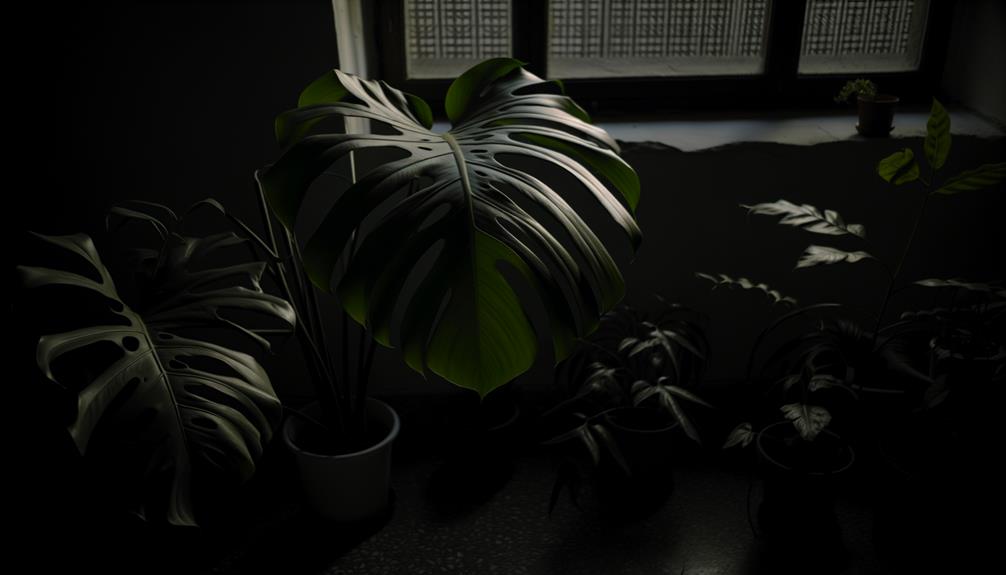
Monstera deliciosa employs several adaptive strategies to survive in low light conditions, including morphological changes and physiological adjustments that optimize light capture and energy efficiency. One significant morphological adaptation is the development of larger leaves with increased surface area, which enhances light absorption.
In addition, Monstera exhibits phototropism, wherein the plant’s stems elongate towards light sources, maximizing photon interception. On a physiological level, chloroplasts reorient within leaf cells to optimize light capture, and the rate of chlorophyll synthesis increases, boosting photosynthetic efficiency under suboptimal light conditions.
Moreover, Monstera deliciosa adjusts its stomatal conductance to reduce water loss, ensuring metabolic processes remain stable. These combined strategies enable Monstera deliciosa to endure and even thrive in environments with limited light availability.
Best Placement Tips
Best placement of Monstera deliciosa in low light environments requires consideration of factors such as proximity to indirect light sources, ambient humidity levels, and temperature stability.
To enhance plant health and growth under suboptimal lighting conditions, adhere to the following scientific guidelines:
- Indirect Light Sources: Position the plant near windows facing north or east to guarantee exposure to diffused natural light, avoiding direct sunlight which can cause photodamage.
- Ambient Humidity: Maintain relative humidity levels between 60-70% to support physiological processes such as transpiration and nutrient uptake.
- Temperature Stability: Maintain ambient temperature within the ideal range of 18-27°C (64-81°F) to prevent thermal stress and promote consistent metabolic activity.
Supplemental Lighting Options
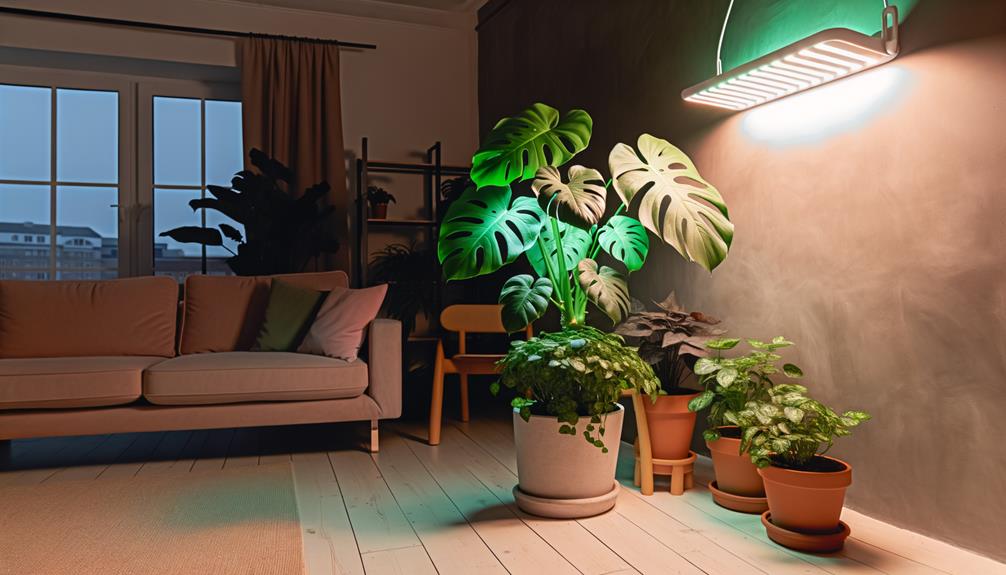
To further enhance growth conditions for Monstera deliciosa in low light environments, implementing supplementary lighting options becomes a vital strategy to guarantee sufficient photosynthetic activity. Utilizing full-spectrum LED grow lights replicates natural sunlight, providing wavelengths necessary for chlorophyll production.
Positioning these lights at an ideal distance of 12-18 inches above the plant ensures even light distribution without causing photodamage. Additionally, maintaining a light period of 12-14 hours daily emulates extended daylight, promoting vigorous growth. Employing timers can automate this cycle, ensuring consistent exposure.
Monitoring light intensity, typically around 2000-3000 lux, is essential to avoid excessive energy expenditure and overheating. Integrating these supplementary lighting solutions can greatly improve the physiological health and aesthetic appeal of Monstera deliciosa in suboptimal light conditions.
Common Mistakes to Avoid
A critical misstep in cultivating Monstera deliciosa under low light conditions is the overestimation of the plant’s tolerance to insufficient illumination, leading to etiolation and diminished photosynthetic efficiency.
To mitigate this, it is essential to avoid certain pervasive errors:
- Inadequate Watering Practices: Overwatering or underwatering can worsen the stress caused by low light, disrupting root function and nutrient uptake.
- Neglecting Soil Composition: Using soil that retains excess moisture can encourage root rot, especially in low-light environments where evaporation rates are reduced.
- Ignoring Pest Infestations: Low light can weaken the plant’s natural defenses, making it more vulnerable to pests. Immediate intervention is crucial to prevent damage.
Understanding and rectifying these common mistakes guarantees the Monstera deliciosa remains strong even under suboptimal light conditions.
Conclusion
To sum up, Monstera deliciosa, while versatile, flourishes like a sun-oriented guide, requiring sufficient light for peak growth. Insufficient brightness can hinder progress, appearing as elongation and yellowing.
Implementing low light adaptation tactics, like strategic positioning and extra lighting, reduces negative impacts. Maintaining adequate light conditions is crucial for the well-being of Monstera deliciosa, much like supplying the correct fuel guarantees the effective operation of an engine.
Steering clear of typical errors additionally enhances plant strength.

